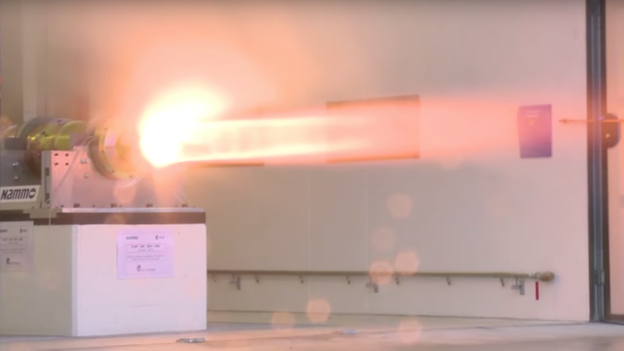Bloodhound supersonic car record bid slips again
- Published

Bloodhound will do tie-down tests and low-speed runs in 2017
The British-led effort to break the World Land Speed Record is going to slip again - to 2018.
The Bloodhound Super-Sonic Car was supposed to go racing later this year, to try to raise the current mark of 763mph (1,228km/h) to over 800mph.
But what are described as "short-term cash flow problems" have put a dent in the schedule.
The upside, says the team, is that it provides additional time to eke more power from the car's rocket.
Engineers want some extra thrust margin just in case the final build of the vehicle turns out to be heavier than expected.
"It's frustrating, I know; and the team are disappointed but we're resilient and we're going to make this happen," Bloodhound director Richard Noble told BBC News.
"The money is coming in but it doesn't always match our planning and fit with the times when we need it."
Fashion backing
In the meantime, the project's education programme, which delivers STEM activities to schools, continues apace. Nearly 100,000 children have participated in the last year, developing their knowledge of maths and physics by constructing and running mini rocket cars.
Bloodhound has signed some big sponsorship deals recently, notably with the Chinese auto manufacturer Geely. This cleared all debts.
Mr Noble said he was also in the process of inking two more - one with a major IT company, and another with a leading fashion brand.
But the time it takes for deals to be agreed, for contracts to be signed, and for money then to flow sometimes leaves Bloodhound cash-short, he explained.
"I'm reasonably happy now that we'll be able to make our budget this year, which is great - and that means we will be on the desert, running the car, probably in mid-summer 2018."
The car itself is all but finished. It was put on static display in October 2015, and then stripped down for a final re-assembly, with fluids, and checks.

Nammo is the technology lead behind Bloodhound's rocket
The plan now is for Bloodhound to do its slow-speed testing (about 200mph) on the runway at Newquay Aerohub in late summer/autumn this year.
A specific date has yet to be announced but it will follow the completion of some "tie down" investigations, in which the car is held in place while its EJ200 Eurofighter jet engine is taken up to speed.
The jet is what will get the car rolling for its assault on the land speed record when it eventually gets to the race track on Hakskeen Pan in Northern Cape, South Africa. But it is the grunt from a rocket that will push the vehicle through the sound barrier and up to 800mph.
Bloodhound's partner on this is the Norwegian aerospace and defence company Nammo.
It is providing in the first instance what is termed a monopropellant rocket. Monopropellants work by pumping High Test Peroxide over a catalyst. This decomposes the liquid to produce super-hot steam that is then vented through a nozzle.
More performance
Nammo has been testing rockets that have produced 30 kilonewtons of thrust. But Bloodhound's engineers would like to get closer to the rockets' expected monopropellant thrust ceiling of 40-45kN.
This would yield some margin in performance if the final assembly of the car turns out to be significantly heavier than the anticipated 7.5 to 7.75 tonnes.
"The car's weight has fluctuated between 200 and 500 kilos from where we thought we were going to be. It's something of a moving feast; we're weighing the car as we're building it," said chief engineer Mark Chapman.
"But if the figures turned out to be pessimistic, we'd look pretty stupid if we turned up at Hakskeen Pan and could only do 680mph. So, the thought was: let's be sure we can get to the speeds we want.
"Nammo are confident they can deliver a 45kN motor. They'll test that motor later this year and then we'll test it in-car next year."
The Bloodhound project was launched in 2008. Back then, the thought was a new record bid would be made in 2011. But the scale of this land speed attempt has dwarfed all previous efforts.
'Bloodhound effect'
Richard Noble was the director for the Thrust SSC car when it set the current world record in 1997. He says just £2.48m in cash was spent to achieve its supersonic mark.
In contrast, the cash spend on Bloodhound is likely to be in the region of £60m. On top of this are a whole host of in-kind contributions, which include the loan of EJ200 engines from the Ministry of Defence and the consultancy work that comes with them from Rolls-Royce.
The companies and scientific institutions involved all speak of a "Bloodhound effect".
The two universities - Swansea and the West of England - who helped to design the car say there has been a big rise in the numbers applying to take their aerospace and engineering courses.
Likewise, engineering firms such as Castle in Glasgow, which has made the aluminium wheels for Bloodhound, say they have found it much easier to attract apprentice applications - a boost it attributes directly to the Bloodhound association.
Jonathan.Amos-INTERNET@bbc.co.uk, external and follow me on Twitter: @BBCAmos, external